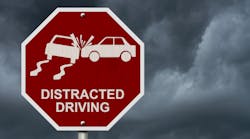Dangerous distracted driving continues across the U.S., and it might have increased in the busy post-pandemic period, as one new study shows. Commercial drivers are part of the problem, as well as a key to the solution, according to the trucking insurance company that performed the survey.
The notable finding from the 2022 Travelers Risk Index: Work-related pressures are a significant contributor to distracted driving, as one-third of respondents stated that their own driving has improved over the past of couple years but admitted to making phone calls and reading text messages while behind the wheel.
“This year’s findings expose a gap between people’s perception that they can drive safely while using their smartphone and the National Highway Traffic Safety Administration data, which shows a 20% increase in car crashes and fatalities since the pre-pandemic levels of 2019,” said Michael Klein, a Travelers executive VP and the company’s president of personal insurance.
See also: How distracted driving led to a lifetime of ‘regret’ for one trucker
“We all play a role in helping to address this public-health crisis,” Klein added in a statement. “It’s imperative that we simply silence our phones while driving and stay focused behind the wheel.”
“The index takes at a very broad look at risk on the roadway—not just in trucking; the issues around the environment,” Chris Hayes, assistant VP of workers compensation and transportation risk control at Travelers, told FleetOwner. “[Truckers] operate on the same roads as everyone we look at with risk on the road. The road we are putting them out on is increasingly dangerous with the drivers that are around them.”
The risk survey from Travelers—its subsidiary Northland is the third largest commercial truck insurer in the U.S.—suggests that work-related pressure might be leading to distracted driving. Truck drivers were not directly surveyed for the risk index, but transportation executives were polled.
Most business managers (86%) said they expect employees to respond to work-related communications at least sometimes while outside the office during work hours, according to the study. One-third of them said they expect employees to answer or participate in work calls while driving, according to Travelers.
Such expectations may contribute to 42% of respondents saying they take work-related calls, texts, or emails while driving. When asked why they do this, 43% said that it might be a work-related emergency, 39% feel they always need to be available, and 19% say their boss would be upset if they don’t answer—even while they’re behind the wheel.
Survey polls transportation execs
The 2022 Travelers Risk Index does a deep dive into a few industries, transportation included. Some of the results from that sector were:
- 87% of transportation respondents have drivers using company vehicles, the highest of surveyed business sectors.
- Transportation executives are the most concerned about liability because of distracted driving by employees; 74% worry a great deal or some.
- 73% of respondents in the transportation sector have a company distracted driving policy. But 61% of respondents stated that employees had been disciplined for violating their policies.
- More than one-quarter (27%) of respondents do not have policies or are unaware of a policy.
- Over one-third (39%) said employees have not been disciplined or are not aware of disciplinary actions for violating these policies where they do exist.
- About one-third of respondents in this industry reported they do not have employee education programs about the dangers of sending or receiving phone calls, texts, or emails while driving and how to avoid distracted driving.
- 54% use technology to track the behavior of employees using telematics when they are driving in company vehicles or for work purposes.
This last statistic is perplexing to Hayes, who’s worked for 23 years in trucking insurance, which is focused these days on the data that can be gathered—on driver behavior and after accidents—by the deployment of telematics. With the advent of telematics, Hayes pointed out, there are higher-tech ways to keep track of employees than distracting them with phone calls or text messages.
See also: Deciphering the calculus of trucking insurance
“ELDs are ubiquitous, but despite this, only 54% of companies use that technology to track driving behavior? People might be overestimating how much they’re using those systems. If they aren’t, they’re leaving a lot of opportunity for data on the table,” he added.
The Travelers Risk Index also found that distracted drivers are more likely to correct their behavior when their passengers speak up. Of the respondents, 87% who use cell phones while driving said they would be less likely to do so if a passenger chimed in. However, the likelihood of passengers speaking up was dependent on who the driver was. For example:
- 44% of respondents would speak up to a friend or family member if they were driving distracted.
- Only 11% would speak up to a co-worker.
- Just 7% would say something to a driver in rideshare, such as Uber or Lyft.
Mileage surging—as are traffic deaths
Another estimate released earlier in March than the Travelers Risk Index showed post-pandemic mileage surging in 2021. It also showed motor-vehicle deaths increasing by 9%.
The National Safety Council (NSC) estimate of total motor-vehicle deaths for 2021 was 46,020, up 9% from 42,339 in 2020 and up 18% from 39,107 in 2019.
Mileage in 2021 rebounded 11% from COVID-19 lows in 2020 and only lagged 2019 mileage by 1%. The estimated mileage death rate in 2021 is 1.43 deaths per 100 million vehicle miles traveled, down 2% from 1.46 in 2020 but up 19% from 1.20 in 2019.
“This devastating news serves as yet another wake-up call for this country. We are failing each other, and we must act to prioritize safety for all road users,” said Lorraine Martin, NSC’s president and CEO. “One life lost in a preventable crash is tragic enough and more than 46,000 in one year is unacceptable.”




